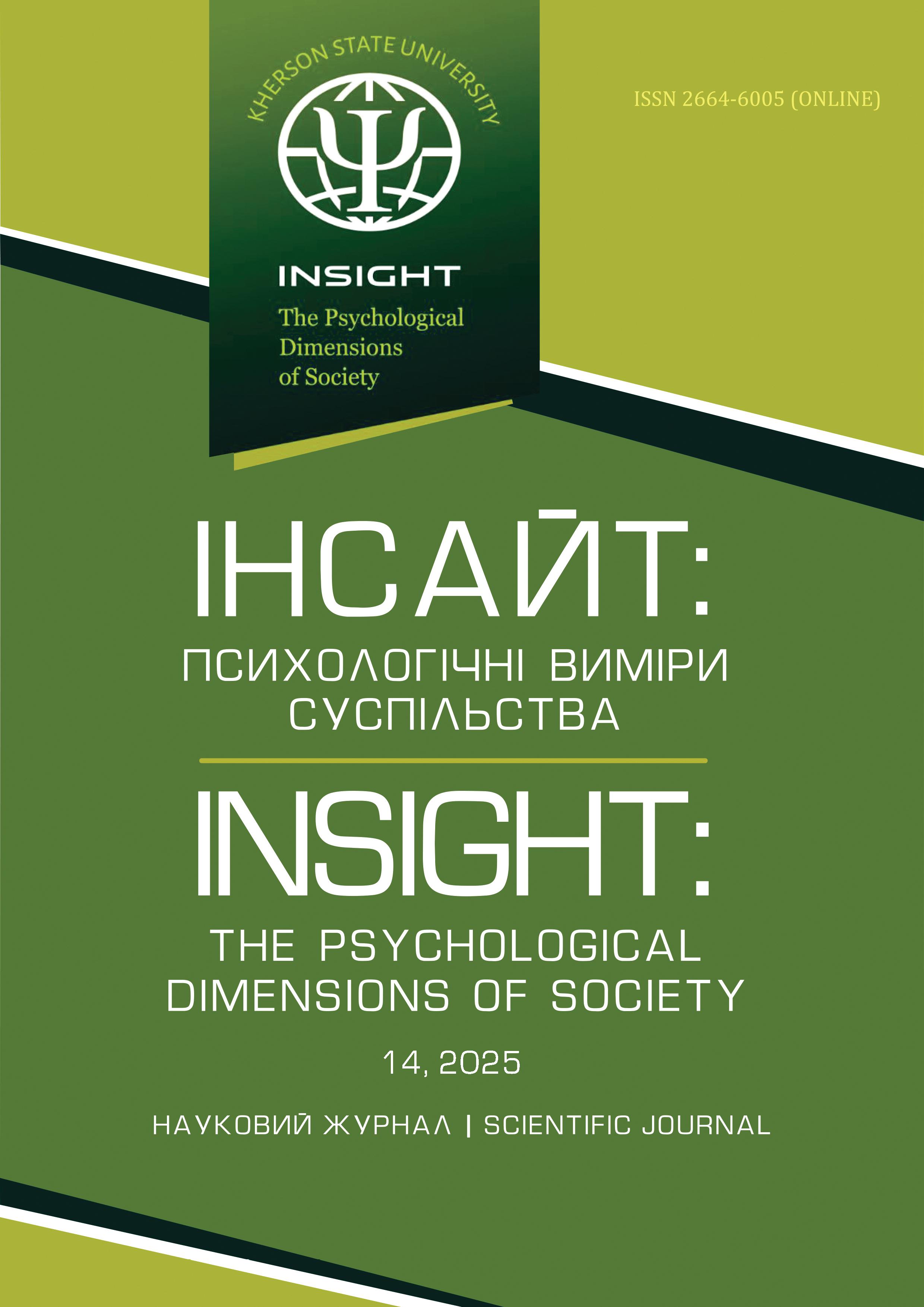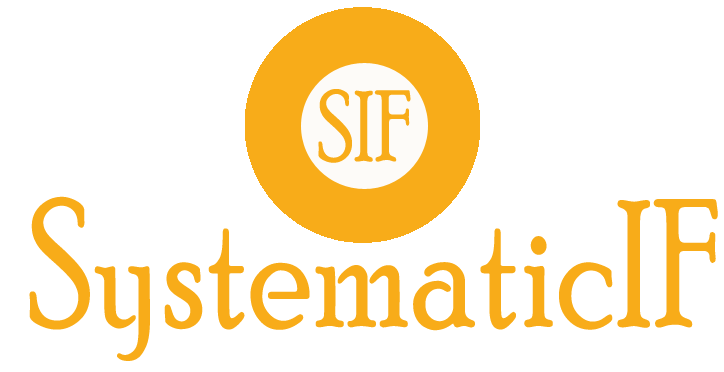Psycholinguistic Mechanisms of Emotion Regulation of Educational Activity
Abstract
The purpose of the research is aimedat revealing the leading psycholinguistic mechanismscharacterising the relationship between thinkingand speaking actions and motivational and emotionalmanifestations in the process of emotion regulationof an individual’s educational activity. The researchobjects are psycholinguistic features of thinkingand speaking actions and motivational manifestationsin the cognitive activity of an individual. Theresearch subjects are psycholinguistic mechanismsof the interaction between thinking and speakingactions and motivational and emotional manifestationsin the conception of emotion regulation of educationalactivity. Results. It was revealed that motivationaland goal-oriented components as well as emotional experiences that accompany and regulate thisprocess play an important role in the manifestationof psycholinguistic mechanisms of thinking and speakingactions of an individual in various types of cognitiveactivity. Certain features of their interaction werefound, taking into account different phases of cognitiveactivity. The characteristics of psycholinguisticmechanisms in cognitive activity, which served asthe basis for the analysis of emotion regulationof educational activity at the levels of searching forgeneralized thinking and speaking actions alongsidesolving educational tasks aimed at the developmentof students’ theoretical thinking, were described.A complex of emotional and communicative methodsand tasks that ensure emotion regulation were given.Discussion and conclusions. A list of simple emotionsand complex cognitive emotional-sensory experienceswhich accompany speaking and thinking actionsand perform various functions taking into accountthe development of the process targeted to solvingan educational task (surprise, curiosity, inquisitiveness,joy, satisfaction, guesswork, interest, disappointment,indifference, etc.) was compiled. It was shown thatsurprise and curiosity are important at the first stage;curiosity and inquisitiveness – at the second stage;interest and joy – at the third stage. The leading emotionprovokingsituations (emotional triggers) and effectswhich can be most favourable at each of the stageswere given (“brightness” and “unexpectedness”to create the effect of “novelty” – at the first stage;“dramatization” to create the “empathy” effect –at the second stage; “complications”, “encouragement”and other ones to create the “inspiration”effect – at the third stage). A conceptual modelof psycholinguistic mechanisms of the interactionof motives, experiences and intellectual-speech actionsof emotion regulation of educational activity was built,taking into account the stages of its deployment whensolving an educational task.
Downloads
References
Bahan, M., Navalna, M., & Istomina, A. (2022). Individual Verbal Codes of Spontaneous Emotional Psychoregulation of Modern Ukrainian Youth. PSYCHOLINGUISTICS, 31(2), 6–32. https://doi.org/10.31470/2309-1797-2022-31-2-6-32
Bamberg, M. (1997). Language, concepts and emotions: The role of language in the construction of emotions. Language Sciences, 19(4), 309‒340. https://doi.org/10.1016/S0388-0001(97)00004-1
Carpendale, J., Lewis, C., Susswein, N., & Lunn, J. (2009). Talking and Thinking: The Role of Speech in Social Understanding. Private Speech, Executive Functioning, and the Development of Verbal Self-Regulation, 83–94. https://doi.org/10.1017/cbo9780511581533.007
Cheban, Yu. V., Chebykin, O. Ya., Plokhikh, V. V. & Massanov, A. V. (2020). Emotional and volitional potential of self-mobilization in the organization of time perspective activity of highly qualified rowing athletes. Journal of Physical Education and Sport, 20(6), 3128–3137. https://efsupit.ro/images/stories/noiembrie2020/Art%20424.pdf
Chebykin, O. (2023). Experimental Study of the Emotional Sphere of Children, Adolescents and Early Adulthood in Ukraine. Routledge. Taylor & Francis Group. London and New York. https://doi.org/10.4324/9781003330943
Chebykin, O., & Maksymenko, S. (2008). Emothional regulation of the Learning Process. Ergonomics and Psychology Development in Theory and Practice. In O. Chebykin, G. Bedny & W. Karwowski (Eds.). London New York: CPC Press Taylor Francis Group Boca Raton, 325–341. https://hsseworld.com/wp-content/uploads/2021/04/Ergonomics_and_Psychology__Developments.pdf#page=344
Chebykin, O., Bedny, G., & Karwowski, W. (2008). Ergonomics and Psychology Development in Theory and Practice. London New York: CPC Press Taylor Francis Group Boca Raton. 412. https://www.routledge.com/Ergonomics-and-Psychology-Developments-in-Theory-and-Practice/Chebykin-Bedny-Karwowski/p/book/9780367387372
Chebykin, A. Ya. (1999). Teoriya i metodika emotsionalnoy regulyatsii uchebnoy deyatelnosti [Theory and Methodology of Emotional Regulation of Learning Activities]. Odessa: Astroprint. http://dspace.pdpu.edu.ua/handle/123456789/1607
Chebykin, O. Ia., & Klenchu, A. M. (2012). Psykholohiia atraktyvnosti divchyny [Psychology of a girl’s attractiveness]. http://dspace.pdpu.edu.ua/handle/123456789/93?locale=uk
Compare, A., Zarbo, C., Shonin E., Gordon, V. C., & Marconi, С. (2014). Emotional Regulation and Depression: A Potential Mediator between Heart and Mind. Cardiovascular Psychiatry and Neurology, 2014, 1–10. https://doi.org/10.1155/2014/324374
Davydov, V. V. (1980). Problemyi razvivayuschego obucheniya [Problems of developmental learning]. Moscow: Pedagogy. http://lib.mgppu.ru/opacunicode/app/webroot/index.php?url=/notices/index/IdNotice:11590/Source:default
Dezecache, G., Mercier, H., & Scott-Phillips, T. C. (2013). An evolutionary approach to emotional communication. Journal of Pragmatics, 59, 221–233. https://doi.org/10.1016/j.pragma.2013.06.007
Käsermann, M.-L., Altorfer, A., Foppa, K., Jossen, S., & Zimmermann, H. (2000). The study of emotional processes in communication: I. Measuring emotionalization in everyday face-to-face communicative interaction. Behavior Research Methods, Instruments, & Computers, 32(1), 33–46. https://doi.org/10.3758/bf03200786
Morhun, V. F. (2020). Perspektyvy vyvchennia topolohii polimotyvatsii osobystosti u diialnisnomu pidkhodi. Problemy motyvatsii osobystosti v suchasnomu osvitnomu prostori: kolekt. Monohrafiia [Prospects for studying the topology of personality polymotivation in the activity approach. Problems of personal motivation in the modern educational space: collective monograph]. In L. V. Gerasimenko, V. F. Morgun (Eds.). Kremenchuk: PP Shcherbatykh O.V., 247–257. http://reposit.nupp.edu.ua/bitstream/PoltNTU/8647/1/%D0%9C%DD0%BE.pdf
Morhun, V. F. (2021). Ratsionalno-suhestyvne navchannia u teorii poetapnoho formuvannia novykh dii. Psykholohiia tretoho tysiacholittia: teoriia, praktyka, eksperyment [Rational-suggestive learning in the theory of step-by-step formation of new actions. Psychology of the third millennium: theory, practice, experiment]. In N. I. Zhyhailo, S. L. Hrabovska, V. F. Morhun (Eds.). Lviv – Toruń: Liga-Pres, 196-224. URL: http://catalog.liha-pres.eu/index.php/liha-pres/catalog/view/147/1796/4320-1
Nanavare, V. V., & Jagtap, S. K. (2015). Recognition of Human Emotions from Speech Processing. Procedia Computer Science, 49, 24‒32. https://doi.org/10.1016/j.procs.2015.04.223
Nosenko, E. L. (1975). Osobennosti rechi v emotsionalnoy napryazhennosti [Peculiarities of speech in emotional tension]. Dnеpropetrovsk: Dnepropetrovsk State University. https://www.libex.ru/detail/book707381.html
Nushikyan, E. A. (1986). Tipologiya intonatsiy emotsionalnoy rechi [Typology of emotional speech intonations]. K.: Vyshcha shkola. https://www.booksite.ru/fulltext/nushikyan/index.htm
Okhrimenko, V., Okhrimenko, M., Gevorgian, K., Uriadova, V., & Shevchenko, I. (2022). Psycholinguistic mechanisms of expression emotion to denote disgust in phraseological pictures of the world in different languages. Journal of Language and Linguistic Studies, 18(SI 2), 1088‒1095. https://www.jlls.org/index.php/jlls/article/view/3988/1080
Popovych, I. S., & Blynova, O. Ye. (2019). The Structure, Variables and Interdependence of the Factors of Mental States of Expectations in Students’ Academic and Professional Activities. The New Educational Review, 55(1), 293–306. https://doi.org/10.15804/tner.2019.55.1.24
Popovych, I., Halian, I., Pavliuk, M., Kononenko, A., Hrys, A., & Tkachuk, T. (2022a). Emotional quotient in the structure of mental burnout of athletes. Journal of Physical Education and Sport, 22(2), 337–345. https://doi.org/10.7752/jpes.2022.02043
Popovych, I., Hoi, N., Koval, I., Vorobel, M., Semenov, O., Semenova, N., & Hrys, A. (2022b). Strengthening of student youth’s mental health using play sports. Journal of Physical Education and Sport, 22(6), 1384–1395. https://doi.org/10.7752/jpes.2022.06174
Popovych, I., Kurova, A., Koval, I., Kazibekova, V., Maksymov, M., & Huzar, V. (2022c). Interdependence of emotionality, anxiety, aggressiveness and subjective control in handball referees before the beginning of a game: a comparative analysis. Journal of Physical Education and Sport, 22(3), 680–689. https://doi.org//10.7752/jpes.2022.03085
Popovych, I., Semenov, O., Hrys, A., Aleksieieva, M., Pavliuk, M., & Semenova, N. (2022d). Research on mental states of weightlifters’ self-regulation readiness for competitions. Journal of Physical Education and Sport, 22(5), 1134–1144. https://doi.org/10.7752/jpes.2022.05143
Roth, W.-M. (2012). Thinking and Speaking. In W. James Jacob, & Wolff-Michael Roth (Eds.). Practice of Research Methods,3, 147‒15. https://doi.org/10.1007/978-94-6091-831-5_10
Tikhomirov, O. K. & Klochko, V. E. (1986). Emotsionalnaya regulyatsiya myislitelnoy deyatelnosti [Emotional regulation of mental activity]. Psychology Issues, 5, 23-31. http://www.voppsy.ru/issues/1980/805/805023.htm
Vygotskiy, L. S. (2000). Myishlenie i rech [Thinking and Speech]. Moscow: EKSMO-Press. https://www.marxists.org/russkij/vygotsky/1934/thinking-speech.pdf
Wierzbicka, A. (1999). Emotions across languages and cultures: Diversity and universality. Cambridge: Cambridge University Press. https://doi.org/10.1017/cbo9780511521256
Zhou, K., Sisman, B., Rana, R., Schuller, B. W., & Li, H. (2022). Speech Synthesis with Mixed Emotions. IEEE Transactions on Affective Computing, 1–16. https://doi.org/10.1109/taffc.2022.3233324
Zhuravlova, L., & Chebykin, O. (2021). The Development of Empathy: Phenomenology, Structure and Human Nature. Routledge; 1st edition. https://doi.org/10.4324/9781003145370
Authors who publish with scientific journal agree to the following terms:
• All scientific papers may be freely copied and distributed on any medium and in any format, provided that the references to the initial data of the scientific work are indicated.
• Authors retain copyright and grant the journal right of first publication with the work simultaneously licensed Creative Commons Attribution License .
• Authors are able to enter into separate, additional contractual arrangements for the non- exclusive distribution of the journal’s published version of the work (institutional repository, your website, monograph), with an acknowledgement of its initial publication in this journal.





































